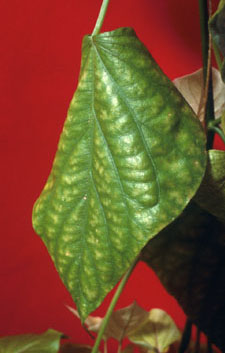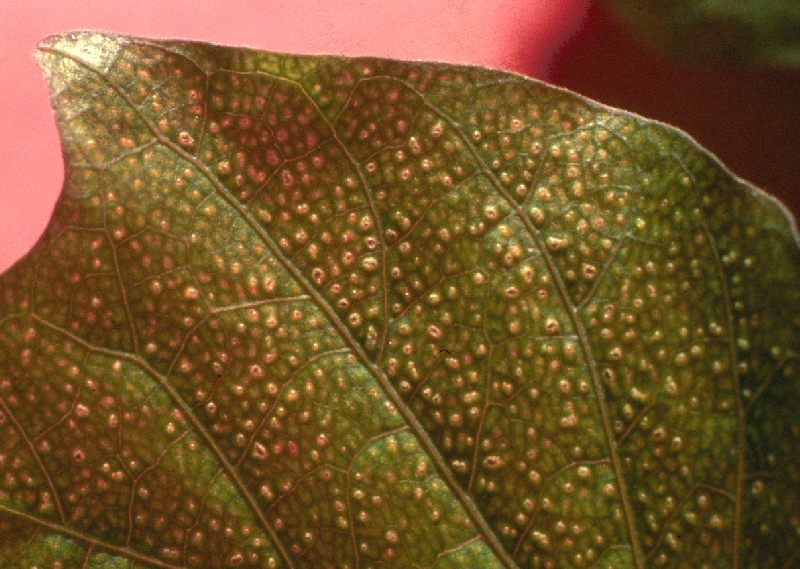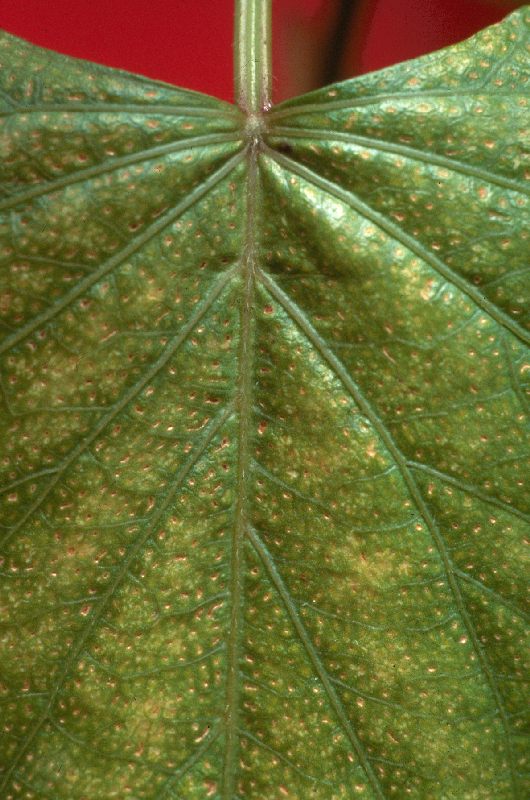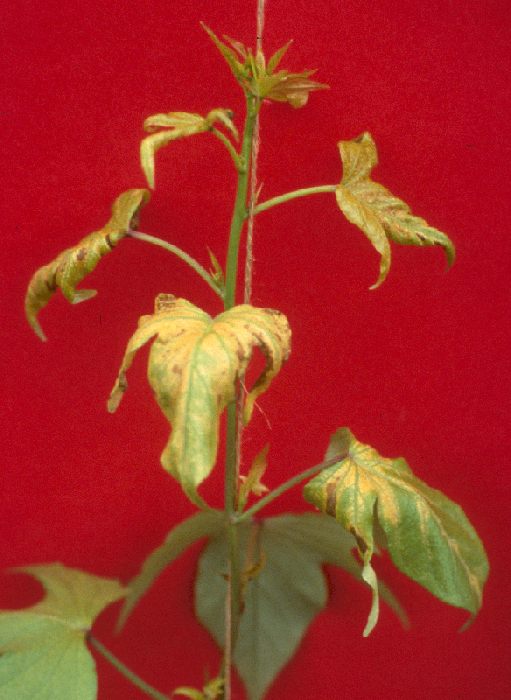|
Manganese (Mn) is present in the soil as free Mn2+, which is readily available to plants,
and as oxides of low solubility. The proportion of manganese in various forms in
the soil is dependent both on chemical reactions and on microbial activity. High
soil pH greatly reduces the solubility of soil
manganese, and therefore its availability to roots. Thus, manganese deficiency
is most likely to occur in soils that are alkaline
or have been limed.
There have been few confirmed field observations of manganese deficiency in
sweetpotato reported in the scientific literature. It has been reported in
sweetpotato grown on coralline soils near Madang, Papua New Guinea, although
sweetpotato was much less affected by the disorder than was yam (Dioscorea
esculenta).
Microbial activity in the soil results in the oxidation of Mn2+ to insoluble
higher oxides. As this is favoured in well-aerated soils, manganese deficiency
may arise intermittently during drier periods, or appear more severe in well
drained parts of the field. Cycles of manganese deficiency and recovery may
result in symptoms normally associated with young leaves appearing on older
parts of the plant.
Usually the first sign of manganese
deficiency in sweetpotato is an indistinct interveinal
chlorosis throughout the plant, but
particularly on leaves of intermediate age. The green zones around
major veins are relatively broad and fade gradually toward the interveinal zone.
In some cultivars, the chlorosis may appear more general than interveinal.
Chlorosis may be accompanied by drooping of the leaves, slight puckering of the
leaf surface or downward
curling of the leaf margins.
The drooping is caused by bending of the petiole and is not accompanied by wiltingof the leaf blades, nor does it progress
to the point of leaf senescence and abscission.
On young, expanding leaves, small areas between minor veins become pale and
sunken, and eventually develop into necrotic spots. While all interveinal zones
of the leaf are affected, they do not develop at the same rate. Indeed, it is
common to see a peppering of brighter, cleared spots across the leaf blade
and necrotic pits develop. Initially, the leaves most affected are
those which are rapidly expanding, a few nodes back from the tip. But as the
symptom intensifies, both older and younger leaves are affected. Pits
in older leaves tend to be darker and are often concentrated near the base of
the midrib and main veins. The young leaves become pale, thickened and
brittle, and may curl under or buckle as they expand. When pitting occurs in
very young leaves, their subsequent expansion causes the pits to develop into
larger holes. In severe cases only a lacy skeleton of the leaf remains.
Severely-affected leaves become necrotic, the necrosis spreading from the tip or
lateral margins. The growing points at the shoot tip and in leaf axils remain
active. Axillary shoots are generally less affected than the subtending leaf.
In cultivars where the leaf blade is
deeply divided into lobes, the above symptoms may be poorly developed. Instead,
small, chlorotic, thickened and deformed young leaves may be produced. The leaf
surface may be finely pitted especially in the vicinity of main veins.
Pillai
et al. (1986) reported that manganese-deficient plants produced small,
thin storage roots which had brownish streaks in the flesh.
Copper
deficiency may also induce interveinal chlorosis and drooping in mature leaves,
but in the case of copper deficiency, there is a distinct wilting of the leaves,
and this may progress to leaf senescence and abscission. This does not occur
with manganese deficiency. The appearance of small, deformed young leaves may
also be mistaken for copper deficiency, although the latter does not typically
induce chlorosis or pitting of the leaf surface.
The clearing of small islands of
interveinal tissue may also be a symptom of copper toxicity. In this case,
however, the chlorosis usually only affects mature leaves, and may occur on only
localised areas of the blade. Symptoms of manganese deficiency tend to be
expressed in young leaves, uniformly across the leaf blade.
A critical concentration of 19 mg Mn/kg
in the 7th to 9th youngest leaf blades was determined in solution culture
studies using cv. Wanmun. In healthy plants, concentrations were generally
between 26 and 500 mg Mn/kg.
Manganese availability in the soil may be
estimated by extraction with a chelating agent such as
diethylenetriaminepentaacetic acid (DTPA). Concentrations of DTPA-extractable Mn
less than 4 mg/kg are considered potentially deficient for a range of root and
vegetable crops.
Suspected cases of manganese deficiency
can be confirmed by leaf painting with a 1% solution of manganese sulfate.
Manganese application causes regreening of chlorotic tissue, and in young leaves
it arrests the development of interveinal pits and enhances expansion of the
treated portion of the leaf blade.
Cultural control
Except on some sandy soils, manganese
deficiency usually arises due to soil conditions which limit the availability of
manganese to plants. Therefore, fertilisation of the soil with manganese may be
ineffective, as the added manganese may become unavailable. Foliar sprays of
0.1% manganese sulfate or chelate, at 2 to 4 kg Mn/ha, may be effective. The
elevation of soil organic matter content, by mulching or composting, will help
to improve the availability of manganese and other nutrients to the crop.
When deficiency occurs at neutral to
acidic soil pH, manganese may be applied to the soil, as either manganese
sulfate or oxide. Rates used for other crops are typically in the range of 10 to
20 kg Mn/ha. Soils low in manganese should not be limed above pH 6.4 (measured
in water).
CFL 1983. Soil Analysis Service Interpretation Charts. Consolidated Fertilizers
Limited, Morningside, Queensland, Australia.
Johnston, M. 1996. Nutrient disorders of root crops growing on raised coral reef landforms
near Madang, Papua New Guinea. In: Craswell, E.T. Asher, C.J. and O’Sullivan,
J.N. (eds.) ACIAR Proceedings No.65: Mineral nutrient disorders of root crops in
the Pacific. pp 127-129.
O’Sullivan, J.N., Asher, C.J. and Blamey, F.P.C. 1997.
Nutrient Disorders of Sweet Potato. ACIAR Monograph No. 48, Australian Centre
for International Agricultural Research, Canberra, 136 p.
Pillai, N.G., Mohankumar, B., Kabeerathumma, S. and Nair, P.G.
1986. Deficiency symptoms of micronutrients in sweet potato (Ipomoea batatas L.).
Journal of Root Crops 12 (2), 91-95.
Rayment, G.E. and
Higginson, F.R. 1992. Australian laboratory handbook of soil and water chemical
methods. Inkata Press, Australia.
Contributed
by:
Jane O'Sullivan |
Characteristics
and occurrence
Symptoms
Confusion
with other symptoms
Diagnostic
tests
Management
References

Mottled interveinal chlorosis with drooping and curling of margins
(J.
O'Sullivan).

Bright translucent spots on young expanding leaves are often the
earliest conspicuous sign (J. O'Sullivan).

Close-up, tiny pockets between minor veins are seen to become pale,
then sunken and necrotic (J. O'Sullivan).


Pits developing on a more mature leaf tend to be
less translucent and more sunken, while those formed on very young
leaves form holes as the leaf expands
(J.
O'Sullivan).

Even in severe cases, the shoot tip usually
stays alive, but leaves develop symptoms as they expand (J. O'Sullivan). |

